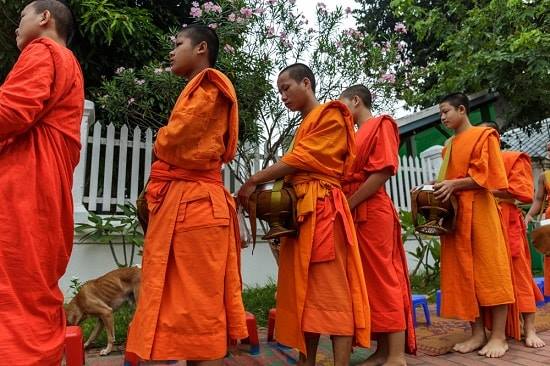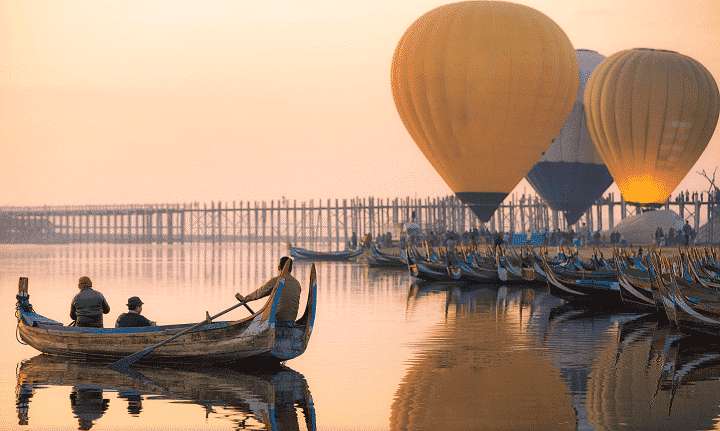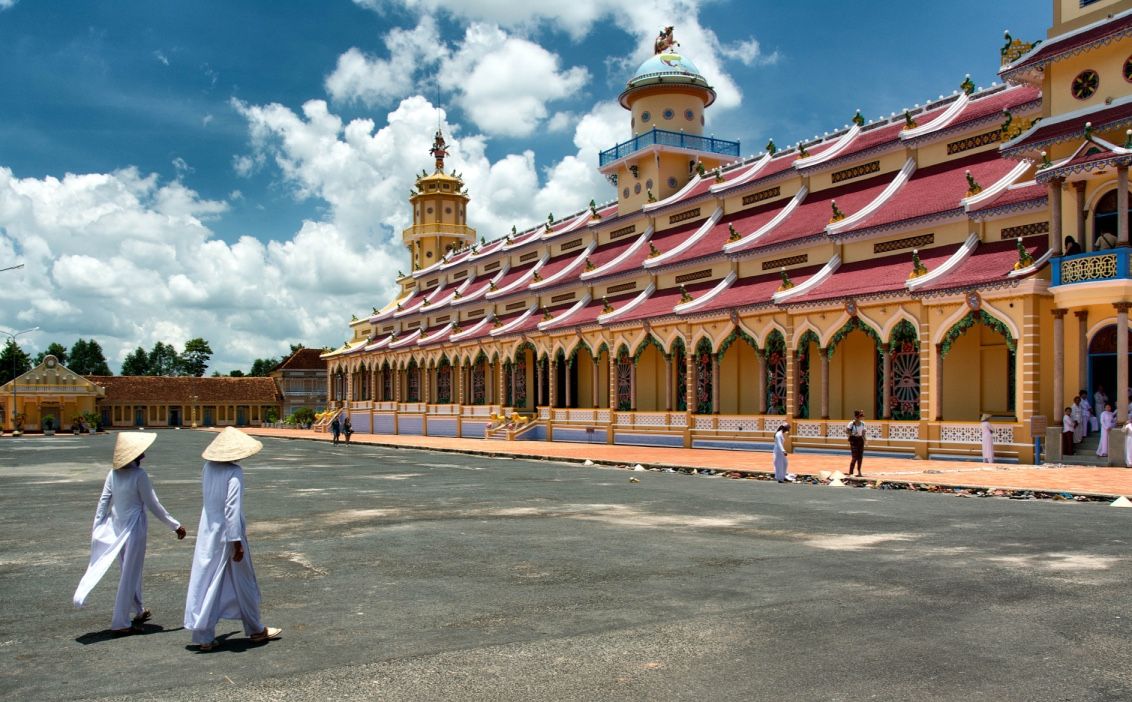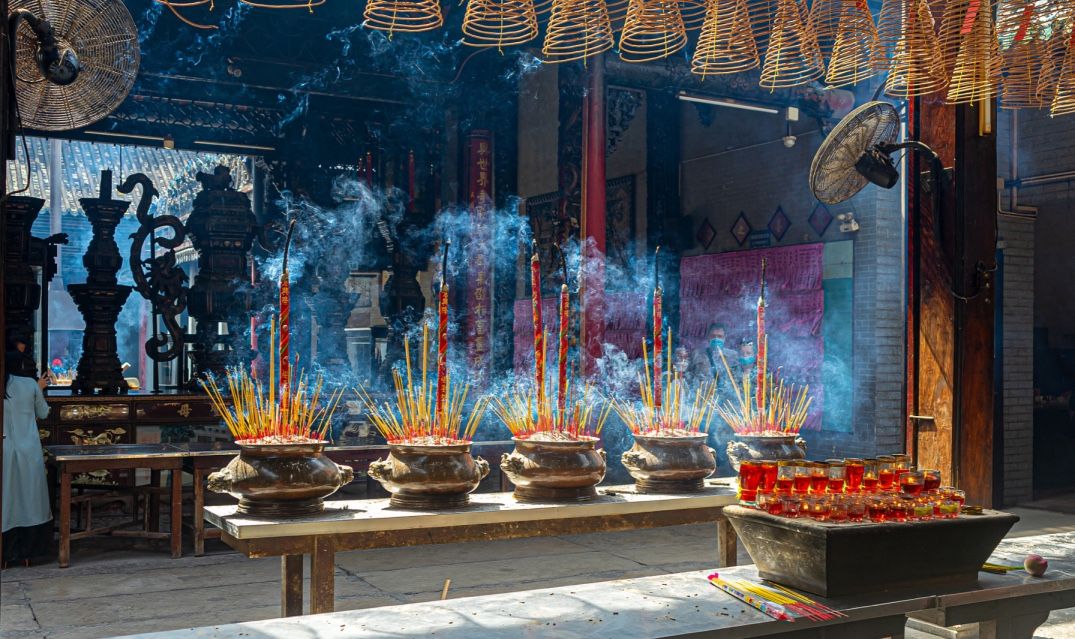VIETNAMESE RELIGION
Buddhism is the principal religion in Vietnam but there are also sizeable Taoist, Confucian, Hoa Hao, Caodaists, Muslim and Christian minorities
Four great philosophies and religions have shaped the spiritual life of the Vietnamese people: Confucianism, Taoism, Buddhism and Christianity. Over the centuries, Confucianism, Taoism, and Buddhism have blended with popular Chinese beliefs and ancient Vietnamese animism to create what is known as Tam Giao (or “Triple Religion”).
In addition to Vietnamese religion – Popular artistic forms include: traditional painting produced on frame-mounted silk; an eclectic array of theatre, puppetry, music and dance; religious sculpture; and lacquerware.
Experience authentic Vietnam & Cambodia in real style on our most popular itinerary → Halong Bay to Angkor Wat 14 Days Tour
Religion in Vietnam → 3 Important Events
Special religious pray are held at Vietnamese and Chinese pagodas on days when the moon is either full or the merest sliver. Many Buddhists eat only vegetarian food on these days. Some of the major religious festivals follow a lunar calendar.
1. Tet (late Jan-early Feb), the most important festival of the year, marking the new lunar year as well as the advent of spring. check out Vietnamese Lunar New Year
2. Wandering Souls Day (August), the second-largest festival of the year, when offerings of food and gifts are given to the wandering souls of the forgotten dead.
3. Holiday of the Dead (April), which commemorates deceased relatives
An Introduction to Vietnamese Religions & Beliefs
Vietnamese are free to choose and accept any spirits, beliefs and therefore, a religion they are happy with. Even though the majority of population in Vietnam marked as non-believer, and or believing on beliefs and practices, to which, this plays a significant role in Vietnamese religion life.
Vietnam is home to every important religion on earth. At least four major tenets have shaped with community and their culture and are manifested either overtly or covertly in habits and conduct. These are Confucianism, Taoism, Buddhism, and Animism.
Christianity became a major religion in Vietnam quiet later. Other religions, like Baha’ism, have also grown in popularity. All of this is rooted in a widespread respect of ancestors. The end product is a synthesis or blend of beliefs with distinctively Vietnamese forms and practices. Vietnam’s Buddhism differs from Buddhism in Thailand, as an example.
The Vietnamese share a number of common beliefs with people in other nations, including theism and animism. The belief in ancestor worship is the most widely held common belief among Vietnamese people.
Buddhism in Vietnam
Buddhist is the largest religion in Vietnam with Ho Chi Minh City as its association center.
In Vietnam, there are two major branches of Buddhism: Mahayana and Theravada. About 200 years ago, Mahayana Buddhism was brought to the Red River Delta from China, and between 300 and 600 years ago, Theravada Buddhism was introduced from India to the southern Mekong Delta.
Vietnamese religion has a long history of localizing Buddhism, giving it a distinct identity. It connects to numerous significant national celebrations and events. The prosperous dynasties of Dinh, Le, Ly, and Tran contributed to the expansion and support of Buddhism, with meditation instructors playing a significant role during their time.
What is Buddhism like in Vietnam?
First of all, Buddhist beliefs align with tradition. For example, sculptures of gods in Vietnam have been adapted to Buddhism and crafted according to Buddha statue standards. The pagoda, once used solely for Buddha worship, now features a “pre-Buddha, post-God” or “pre-Buddha, post-Mother” design. In the pagoda, the Vietnamese worship gods, saints, Mother, the local goddess, and the national hero.
Second, Vietnamese Buddhism promotes harmony. In the north, a pagoda features Buddha, bodhisattvas, and arhats from various sects. In the south, a small statue of Sakyamuni Buddha stands beside two other statues: one in blue and one in gold, next to a statue in brown attire.
Taoism & Confucianism complement Buddhism
Thirdly, Taoism & Confucianism complement Buddhism. In Vietnam, the ideas of “Tam giao dong nguyen” (three religions, same origin) and “Tam giao dong quy” (three religions, same aim) emerge from the blending of Buddhism, Taoism, and Confucianism. Together, these three religions shapes human life: Buddhism addresses spiritual and afterlife concerns, Taoism focuses on the physical body, and Confucianism governs society. Additionally, the fusion of Buddhism with other religions led to the creation of Cao Dai.
Religion in Vietnam: Matriarchy Buddhism
Although the Buddha typically appears as a man in India, however, in Vietnam Buddhas features both male and female. Vietnamese Buddhist culture introduced its own Buddha-Mother, including Quan Am Dieu Thien (Buddha in Perfume Pagoda), Man Nuong Buddha (Phat Mau), and Quan Am Thi Kinh (Quan Am Tong Tu).
Some of the must-see visited pagodas in Vietnam, including One Pillar Pagoda, Tran Quoc Pagoda, and Perfume Pagoda in outskirts of Hanoi; Thien Mu Pagoda in Hue; Linh Phuoc Pagoda in Dalat; and Giac Lam and Vinh Nghiem Pagodas in Ho Chi Minh City.
Dress Code & How to Visit Pagodas in Vietnam
Dress properly, avoid shorts, skirts, and tank tops.
Buddhist worship the altar from the middle point, then clockwise from right to left.
It is more polite & discreet to enter the temple from the side doors rather then the main door in the middle.
Avoid pointing at Buddha statues and try to remain quiet.
Do not disturb the prayers by cutting their praying niche.
Christian in Vietnam
Spanish and Portuguese missionaries introduced Christianity to Vietnam in the early 16th century. They first settled in Nam Dinh and expanded Christianity throughout the coastal provinces towards Thai Binh, Ninh Binh, and Thanh Hoa. Eventually, Christianity reached the Red River Delta and Hanoi.
Christian impact on Vietnamese culture
The primary challenge faced by Vietnamese clergy members is the difference in language and writing styles. Although they can pick up the sound quickly, the written language—which is based on Chinese alphabet—is too challenging for them. In order to overcome this, they recorded Vietnamese using the well-known Latin script together with indicators that are accessible in languages like Portuguese and Spanish. Slowly, this replaced the Chinese alphabet and was recognized as the state script know as Quoc Ngu alphabet
Along with the change of alphabet and introducing Christianity in Vietnam – missionaries have also brought techniques of writing the script along with the printing machine into Vietnam.
Christianity introduced science & medicine
Early Vietnamese Christian missionaries were educated in Western institutions, built hospitals and brought western medicine and treatment method to Vietnam.
Since Christianity started to grow as a religion in Vietnam, community also started to build their own churches, well-known including; Vietnam are Notre Dame Cathedral in Ho Chi Minh City, Phat Diem Cathedral in Ninh Binh, Domaine De Marie Church in Dalat, and St. Joseph’s Cathedral in Hanoi.
Cao Dai Religion in Vietnam
Among all the other religion in Vietnam – the monotheistic Cao Dai religion was founded in southern Vietnam in 1926 dedicated to God rather than any prophet or even Buddha.
Followers of Cao Dai believes in vegetation diet, ancestor worship, nonviolence, and pray to god and they believe that all religions in the world have one main mission and that is living the life and eventually when the time comes, God and humanity will join together like never happened before.
Numerous major world faiths, such as Buddhism, Confucianism, Christianity, Hinduism, Islam, Judaism, Taoism, and the folk Vietnamese religion of Genie, are combined with aspects in Caodaism.
Traditional folk beliefs in Vietnam
Vietnamese folk religion worshipped a wide variety of gods from ancient times, especially those associated with agriculture, such as the sun, moon, land, mountains, rivers, and woods, since Vietnamese believe that everything has a soul.
Vietnamese ethnic minority follows its own set of traditional folk beliefs and rituals. Some of the minorities with their own special beliefs including: Tay-Thai, H’Mong-Dao, Hoa-San Diu-Ngai, Cham-Ede-Gia Rai, and Mon-Khmer.
In addition to folk beliefs in Vietnam, ancestor worship & death anniversary celebrations stand out as the most revered traditions. Every Vietnamese family prioritizes remembering the anniversaries of their ancestors’ deaths and has an altar for ancestor worship.
Religion in Vietnam: Worshiping the Village Deity
Vietnamese communities have a communal temple devoted to the Village god, which comprises worshiping a god in the village’s temple together with the ancestor worship. The Village Deity may be a god or an important person who used to play a key-role or a war hero who made a major contribution to the country’s defense.
Vietnamese people also worship other gods, such as the God of the Soil and the Kitchen God.
Tolerance is a top feature of Vietnamese religious attitudes. Vietnam has never seen religious extremism or conflict over a religion. Comprehending religion in Vietnam is essential to appreciating many facets of Vietnamese society since religious convictions impact nearly every idea and behavior, influencing how others view us and our behavior.
Vietnam religion percentage 2025
Religions in Vietnam: FAQ
Vietnam is one of the world’s least religious nations, people are free to choose their own belief, traditions and therefore the religion they are happy with. Vietnam’s religious history proves that the nation has never been in religion conflict and there has never been any restrictions on freedom of religion.
Here, we answer some of the Frequently Asked Questions about the “Beliefs & Religion in Vietnam”
What are the major religions of Vietnam?
Buddhism leads as the predominant religion in Vietnam, with 50% of the population identifying as Buddhist. Confucianism and Taoism reflect deep Chinese influences in Vietnamese culture. Portuguese missionaries arrived in Vietnam in the sixteenth century, and today, Catholics make up about 7% of the population.
Are there Muslims in Vietnam?
Like Hinduism, Islam religion in Vietnam have mainly been practiced by the Cham ethnic group. Those with mixed ethnic backgrounds who live in the southwest part of the Mekong Delta region in southern Vietnam are also included in the Muslim community; they are commonly referred to as Cham or Cham Muslims.
What is the fastest growing religion in Vietnam?
Protestants, sometimes referred to as “đạo Tin Lành” locally, comprised approximately 1% of the Vietnamese population as of 2022. Protestantism, though still a minority religion, is expanding at the fastest growing religion in Vietnam, having grown by an astounding 600% in the first few years of the new millennium.
Are most Vietnamese atheist?
Vietnam is unique among the nations with the largest percentage of atheists, with over 25% of its people identifying as such. By contrast, about 20% of people in Singapore identify as atheists. Malaysia reports a much lower figure, with only 2.1% of its people identifying as atheists.
Is Christianity legal in Vietnam?
It is – The constitution guarantees the right to freedom of belief and religion for all individuals in Vietnam, including the right to follow no religion. It also recognizes the freedom of religion or belief for those whose rights are restricted, such as inmates, foreigners, and stateless persons. This legal framework supports various religions, including Christianity in Vietnam, while also accommodating those with no religious affiliation.
Is religion restricted in Vietnam?
The Vietnamese Constitution, which protects everyone’s freedom of belief and religion, is highlighted in the report. However, for reasons pertaining to social cohesion and national security, the Law on Belief and Religion contains ambiguous clauses that may restricted religious freedom in Vietnam.
Why is Vietnam so Catholic?
Christianity constitutes just over 7% of the population in Vietnam. Spanish Franciscans and Dominicans from Malacca and the Philippines introduced Roman Catholicism to the country in the sixteenth century. They did not, however, plan or carry out many missionary endeavors during this time.
Which country is 100% atheist?
Czechoslovakia and East Germany also introduced similar laws about Atheism. Throughout its sphere of influence, the Soviet Union attempted to stifle open displays of religion, especially in Central Asia. North Korea, Vietnam, and China all formally hold atheist positions in their religion life.
Is Vietnam safe for Muslims?
As described above, Vietnam is a safe, peaceful and a religious friendly toward ANY religion or beliefs. Muslim tourists are welcome and there are mosques in both Hanoi and Ho Chi Minh city for praying. There are also a going number of Halal foods & restaurants and a growing muslim community from other nations living in Vietnam as an expat.
Copyright 2013-2017 Vietnamese Private Tours Ltd With Vietnam Luxury Travel







